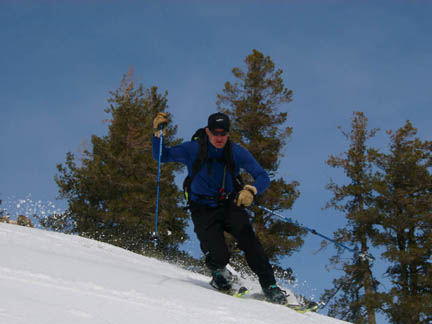Search and Rescue
Dirk Schoonmaker ’80 skis the mountains of Tahoe, Calif., saving lives.
Sub-zero temperatures. A load of 25-plus pounds of gear. Skiing and searching. “You yell out the victim’s name all night long, and then, finally, you hear a call back, ‘Hey.’ It sends shivers down your spine,” says Dirk Schoonmaker, a 17-year ski volunteer with the Tahoe Nordic Search and Rescue (TNSAR), a primarily winter mountain rescue team in Tahoe, Calif.
Schoonmaker has turned his passion for the mountains and the sport of skiing into a commitment to save lives. For him, the TNSAR is his way of giving back to the world. “After I returned from visiting my sister who was working in Senagal for the Peace Corps [in 1985], I pledged that I would do some form of volunteer work,” he says. Initially he was a volunteer firefighter. That turned into a full-time job from which he retired in 2008 after 22 years of service and started his own handyman/contracting business that same year. In 1992, he joined the TNSAR.
In 1996, after climbing with his girlfriend Marty, a physical therapist, to the 21,247-foot summit of Mera Peak in Nepal, with Mt. Everest in view, he asked her to marry him. “On our wedding invitation,” he recalls “we said that I proposed because I was short of oxygen and she said yes because she thought I said ‘carry.’” They now have two children, James Clinton and Mera, and live in the home Schoonmaker built in the late 1990s.
He takes pride in their nearly 3,000-square-foot, three-bedroom, three-bath, two-car garage home, which took two years to build. “Out here, a typical home costs $110 to $150 a square foot. I built ours for $42 a square foot.”
Schoonmaker, who stays in shape by back-country skiing three to seven times a week and biking, says most of the TNSAR searches are at the Alpine Meadows, Squaw Valley, and Sugarbowl resorts, for skiers or snowboarders who have left a trail’s boundaries. “They think they’ve found a great powder run that no one knows about and that they’ll find a ski lift at the bottom.
“Often this occurs during a storm; we are called out after the ski area closes and the person’s friends report them missing, so it’s usually nighttime,” he says. “Our team will go out in any weather, day or night, and search on any kind of terrain, as long as we feel the conditions are safe. We have skiers and volunteers who go out on snowmobiles and a snowcat (a truck-sized vehicle designed to move across snow). We average about 12 missions a year.”
Schoonmaker, who has logged approximately 100 missions since he started volunteering, describes a recent search for a 15-year-old Boy Scout. “The teenager left Sugarbowl ski area’s boundaries and skied into a canyon that turns into a long flat valley after a 1,500-foot decent. With about five feet of new snow on the ground, he was not able to ski out. He used his cell phone to call for help and our snowcat, snowmobilers, and Sugarbowl’s patrollers were able to find him and pick him up. He was cold, but fine.
“Most of our searches end with good outcomes, but in the last two years we’ve found six people who died due to exposure or avalanches. It’s shaken a few of our team members, but they’re getting through it.”
He says the best therapy for dealing with tragic situations is to talk about it afterwards. “We have a critical incident stress debriefing session with other members immediately after the mission, another with a sheriff, and a third secular meeting with a cleric. I will also call the member’s spouse or family members and encourage them to ask about what happened. The more a person talks about it, he says, the more that person is able to integrate the whole experience.
“Members need to realize they didn’t cause the problem. They were just trying to help and did the best they could,” he says.
The TNSAR team also educates. Each year, team members visit every fourth-grade class in the region to teach students how not to get lost and what to do if they do get lost.
The camaraderie of the 90-member team, 44 percent of whom are women, is what Schoonmaker appreciates most. “It’s a great bunch of people. The members are my best friends,” he says. Each month, the all-volunteer team attends five training sessions of four to six hours each. They work on skills such as how to use a GPS system, handle beacons, and read terrain maps.
“Some people are trying to save the world,” Schoonmaker says. “I’m doing it one by one. In my years with the team, I’ve saved 20 lives. I figure that’s a lot of mothers, fathers, and kids who get to hug each other on the night of their rescue. It’s a good feeling, and that’s satisfaction enough for me.
 Email This Page
Email This Page

April 6th, 2010 7:26 pm
I cannot tell you how surprised I was to open the Bulletin and find the story of my son's Alpine rescue described. He was the lost Boy Scout that Dirk mentioned in this article. I didn't know Dirk at Swarthmore but we were there at the same time! I am full of gratitude and admiration for the work Dirk is doing with TSNAR. After deconstructing the events thoroughly with my son, lecturing, etc, we even had a bit of fun reading Dirk's accounts of past rescues on the TNSAR website…the group clearly has a sense of humor and great cameraderie. Thank you Dirk et al.
April 7th, 2010 9:17 am
Thanks so much for your help in saving my Grandson, Simon Fox, the 15-yr old Boy Scout.
God bless you and your colleagues!